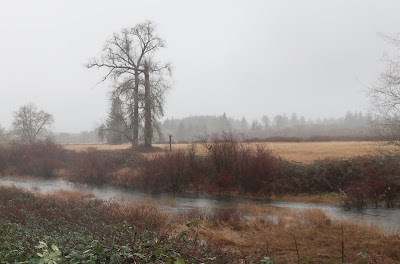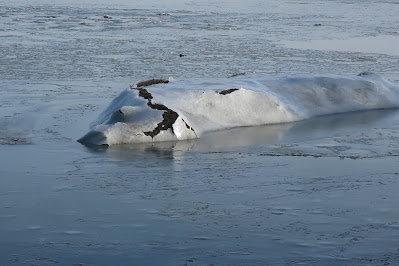I have observed that large swaths of Shaw Island and Lopez Island are covered with stands of lodge pole pine. The lodge pole appear to do well in silty glacial till soils. The glacial till is very dense and hard and has very low rates of permeability. The upper soil above the unweathered till is only about 1 to 2 feet thick. Hence, the upper soil layer becomes saturated in the winter. Lopez and Shaw Islands are within the rain shadow of the Olympic Mountains so the total rainfall results in the till becoming essentially desiccated in the summer. Another climate factor is the San Juan Islands area subject to periodic very cold temperatures associated with the Arctic outflow of air from the Fraser River to the northeast. The combination of wet winter ground, dry ground in the summer and high very cold wind is a good match for lodge pole.
During a recent venture I came across lodge pole pines growing within a logging road on the steep upper northeast slope of Mount Constitution on Orcas Island. The logging road was beginning to get colonized by brush and trees.
The seedlings on the road were primarily western hemlock and lodge pole pine. There were a few Douglas fir seedlings, but they were heavily browsed by deer as was the ocean spray brush. There were couple of Sitka spruce seedlings as well. The dominant tree in most of this forest outside the clear cut is Douglas fir, but western hemlock thrives on this wet shady northeast facing slope and there are numerous clusters of Sitka Spruce in the near vicinity and scattered through this forest area likely due to the cooler temperatures and relatively high rainfall on the upper slopes of Mount Constitution. The lodge pole in this cool wet area appears to be a pioneer tree taking advantage of the wet hard ground of the old road bed. Large area of the upper part of Mount Constitution has stands of lodge pole possible due to the the same combination of wet winter and dry summer conditions but also the upper summit area gets very high wind from all directions and perhaps that and a periodic in the past lightning stikes provided the openings that lodge poles thrive in.
My home ground on Samish Island on the northern edge of the Skagit River delta is underlain by concrete like glacial till and goes from wet soggy ground to desiccated every year. It is also subject to very high winds. In particular the south and east winds knock trees down regularly in the winter on out portion of the island. Elsewhere on the island it is the north or west wind.
Given that the seedlings on the road were doomed I took a few lodge pole seedlings and one Sitka spruce seedling home.
Assessing the forest is not my area of expertise, but I have accumulated a few observations and try to keep learning. I did find some igneous rocks that I tentatively interpret to be part of the Turtleback Complex.















